CNN has an interesting article on Trump supporters in Youngstown, Ohio. Trump fans will like what they read (even 18 Democratic precinct captains voted for Trump). But what struck me was the interview with voters. I don’t know what makes me sadder, the fact that they think Trump sincerely wants to help them, or their belief that he could bring back steel jobs if he were sincere. Contrarian intellectuals tell us regular intellectuals that we need to “listen” to what the working class voters are saying. But when I listen all I hear are pathetic fairy tales.
Back in 1967, the US steel industry employed about 780,000 workers, and produced about 115 million tons of steel. By 2015, employment had fallen to 90,000, producing about 79 million tons of steel. In both years the US consumed about 130 million tons of steel. (I’m not sure these figures are exactly right, but I think they are close enough.)
The bottom line is that even if we still produced 115 million tons, or even upped it to 130 million, the level of employment in steel would be in the 120,000 to 150,000 range. The vast majority of those 780,000 steel jobs were lost to automation, and they aren’t coming back.
Back in the late 1800s, William Jennings Bryan told farmers their problems were caused by eastern bankers, whereas the real problem was that rapid productivity improvements were relentlessly lowering relative food prices and driving farmers into the cities. Trump blames Mexico and China for problems that are actually caused by automation.
PS. I’m not certain about the 780,000 figure, which was derived by multiplying 4.4% times 17.9 million manufacturing workers in 1967. This source reports 521,000 steel employees in 1974, and another source listed 680,000 in 1953. So I’m not sure the peak employment level. There may be definitional issues from different sources.
PPS. The Springsteen song “Youngstown” lamented the collapse of a once proud economic dynamo. It was written in 1995, before Trump scapegoats like NAFTA and China had any significant impact.


